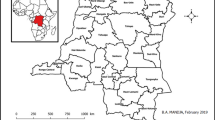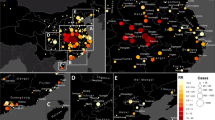Abstract
Infectious viral diseases are emerging worldwide and become a major threat to human life and economy. The emergence of viral pandemics is thought to be driven mostly by environmental changes; however, systemic study is lacking in this field. The aim of this study is to investigate thoroughly the impact of climate change, pollution and deforestation on viral pandemic events and host–virus interactions for the period of 2000–2020 using statistical tools. During the study period several pandemic viral diseases occur globally, the most devastating of which is the infection of SARS-CoV-2 or Covid-19. Besides, Ebola haemorrhagic fever, Rift Valley fever, West Nile fever, yellow fever and Zika viral disease cause death of thousands of people every year all over the world. Influenza outbreaks are also increasing and many animal influenza viruses cross the zoonotic barrier in recent times and becoming fatal for human being, such as highly pathogenic avian influenza A(H7N9), A(H5N1) and A(H5N6). Increasing deforestation causes more contact of wild animals with human and may help in disease transmission. The number of viral-affected individuals during the study period is positively correlated with global average temperature, nitric oxide emission and carbon dioxide emission, whereas negatively correlated with the percentage of forest area. Modern medicine cures many of the viral diseases, but newer viruses intrude into the human domain due to altered human activities. So, restoration of global climate should be the foremost goal of mankind for saving own lives.
Access this chapter
Tax calculation will be finalised at checkout
Purchases are for personal use only
Similar content being viewed by others
References
Alexander, K. A., Carlson, C. J., Lewis, B. L., Getz, W. M., Marathe, M. V., Eubank, S. G., & Blackburn, J. K. (2018). The ecology of pathogen spillover and disease emergence at the human-wildlife-environment interface. In The connection between ecology and infectious disease (pp. 267–298). Springer, Cham.
Arendt, F., & Scherr, S. (2019). Investigating an issue–attention–action cycle: A case study on the chronology of media attention, public attention, and actual vaccination behavior during the 2019 measles outbreak in Austria. Journal of Health Communication, 24(7–8), 654–662.
Buscema, M., Asadi-Zeydabadi, M., Lodwick, W., Nde Nembot, A., Bronstein, A., & Newman, F. (2020). Analysis of the ebola outbreak in 2014 and 2018 in West Africa and congo by using artificial adaptive systems. Applied Artificial Intelligence, 34(8), 597–617.
Chen, C. W., Hsieh, Y. H., Su, H. C., & Wu, J. J. (2018). Causality test of ambient fine particles and human influenza in Taiwan: Age group-specific disparity and geographic heterogeneity. Environment International, 111, 354–361.
Ciencewicki, J., & Jaspers, I. (2007). Air pollution and respiratory viral infection. Inhalation Toxicology, 19(14), 1135–1146.
Contini, C., Di Nuzzo, M., Barp, N., Bonazza, A., De Giorgio, R., Tognon, M., & Rubino, S. (2020). The novel zoonotic COVID-19 pandemic: An expected global health concern. The Journal of Infection in Develo** Countries, 14(03), 254–264.
Dhama, K., Patel, S. K., Sharun, K., Pathak, M., Tiwari, R., Yatoo, M. I., … Rodriguez-Morales, A. J. (2020). SARS-CoV-2 jum** the species barrier: zoonotic lessons from SARS, MERS and recent advances to combat this pandemic virus. Travel Medicine and Infectious Disease, 101830.
Domingo, J. L., & Rovira, J. (2020). Effects of air pollutants on the transmission and severity of respiratory viral infections. Environmental Research, 109650.
Gao, F., Bailes, E., Robertson, D. L., Chen, Y., Rodenburg, C. M., Michael, S. F., … Hahn, B. H. (1999). Origin of HIV-1 in the chimpanzee Pan troglodytes troglodytes. Nature, 397(6718), 436–441.
Hurst, C. J., & Adcock, N. J. (2000). Relationship between humans and their viruses. Viral Ecology, 519.
Iuliano, A. D., Roguski, K. M., Chang, H. H., Muscatello, D. J., Palekar, R., Tempia, S., … Mustaquim, D. (2018). Estimates of global seasonal influenza-associated respiratory mortality: A modelling study. The Lancet, 391(10127), 1285–1300.
Kushmaro, A., Awerbuch-Friedl, T., & Levins, R. (2015). Temperature effects on the basic reproductive number (R0) of west nile virus, based on ecological parameters: endemic vs. new emergence regions. Journal of Tropical Diseases & Public Health, S1–001.
Manisalidis, I., Stavropoulou, E., Stavropoulos, A., & Bezirtzoglou, E. (2020). Environmental and health impacts of air pollution: A review. Frontiers in Public Health, 8, 14.
Obadia, T., Haneef, R., & Boëlle, P. Y. (2012). The R0 package: A toolbox to estimate reproduction numbers for epidemic outbreaks. BMC Medical Informatics and Decision Making, 12(1), 1–9.
Patel, M., Dennis, A., Flutter, C., & Khan, Z. (2010). Pandemic (H1N1) 2009 influenza. British Journal of Anaesthesia, 104(2), 128–142.
Semenza, J. C., & Menne, B. (2009). Climate change and infectious diseases in Europe. The Lancet Infectious Diseases, 9(6), 365–375.
Singer, M. (2009). Pathogens gone wild? Medical anthropology and the “swine flu” pandemic. Medical Anthropology, 28(3), 199–206.
Wang-Shick, R. (2017). Chapter 15—Influenza viruses. In Molecular virology of human pathogenic viruses (pp. 195–211). Academic Press, ISBN 9780128008386.
Woolhouse, M. E., Haydon, D. T., & Antia, R. (2005). Emerging pathogens: The epidemiology and evolution of species jumps. Trends in Ecology & Evolution, 20(5), 238–244.
World Health Organization. (2015a). A manual for estimating disease burden associated with seasonal influenza. World Health Organization.
World Health Organization. (2015b). Middle East respiratory syndrome coronavirus (MERS-CoV): Summary of current situation, literature update and risk assessment (No. WHO/MERS/RA/15.1). World Health Organization.
World Health Organization. (2020). Origin of SARS-CoV-2, 26 March 2020 (No. WHO/2019-nCoV/FAQ/Virus_origin/2020.1). World Health Organization.
Wu, X., Lu, Y., Zhou, S., Chen, L., & Xu, B. (2016). Impact of climate change on human infectious diseases: Empirical evidence and human adaptation. Environment International, 86, 14–23.
Zhong, N. S., Zheng, B. J., Li, Y. M., Poon, L. L. M., **e, Z. H., Chan, K. H., … & Guan, Y. (2003). Epidemiology and cause of severe acute respiratory syndrome (SARS) in Guangdong, People’s Republic of China, in February, 2003. The Lancet, 362(9393), 1353–1358.
Zipprich, J., Winter, K., Hacker, J., **a, D., Watt, J., & Harriman, K. (2015). Measles outbreak—California, December 2014–February 2015. MMWR. Morbidity and Mortality Weekly Report, 64(6), 153.
Acknowledgements
The author is thankful to the Hon’ble Vice-Chancellor of Vidyasagar University to provide infrastructural facility to carry out this research.
Author information
Authors and Affiliations
Corresponding author
Editor information
Editors and Affiliations
Rights and permissions
Copyright information
© 2023 The Author(s), under exclusive license to Springer Nature Singapore Pte Ltd.
About this chapter
Cite this chapter
Ghosh, N. (2023). Viral Pandemic Caused by Intense Abuse on Environment. In: Das, R.C. (eds) Economic, Environmental and Health Consequences of Conservation Capital. Springer, Singapore. https://doi.org/10.1007/978-981-99-4137-7_15
Download citation
DOI: https://doi.org/10.1007/978-981-99-4137-7_15
Published:
Publisher Name: Springer, Singapore
Print ISBN: 978-981-99-4136-0
Online ISBN: 978-981-99-4137-7
eBook Packages: Economics and FinanceEconomics and Finance (R0)




